Are you curious to know what types of water snakes are found in North Dakota? Well, if so then you have come to the right place. Believe it or not, North Dakota has no true water snakes, but it is home to two semi-aquatic snakes and a few wetland snakes.
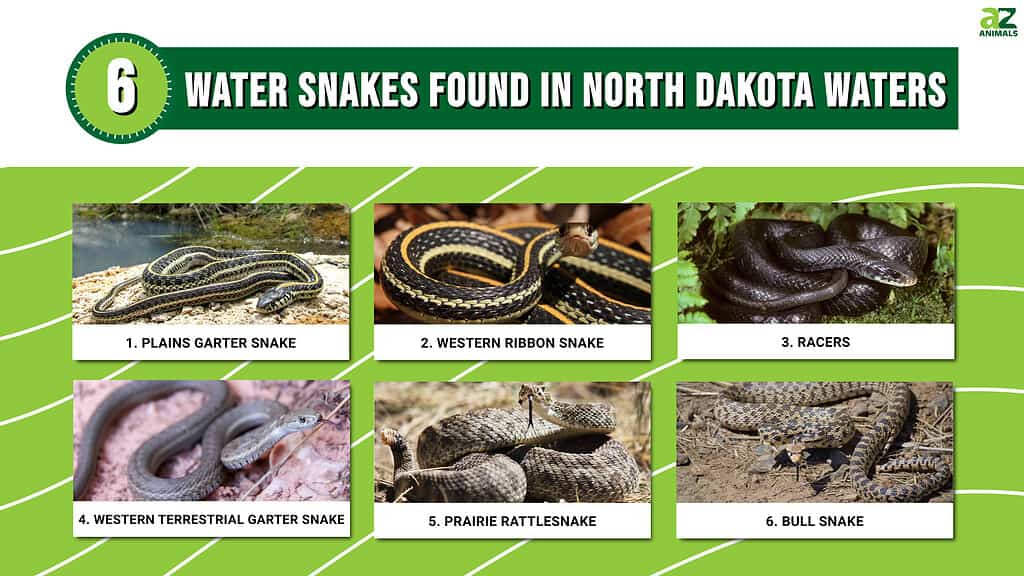
©
Semi-aquatic snakes are snake species that have adapted to living in both aquatic and terrestrial environments. These snakes are most commonly found in freshwater habitats such as rivers, ponds, and streams, but they can also be found in other wetland habitats such as swamps and marshes. Semi-aquatic snakes have a variety of specialized adaptations that allow them to survive in these environments, including the ability to swim, breathe through their skin, and hunt for prey underwater.
A wetland snake is a snake species that is commonly found in and around wetland habitats or water sources, such as swamps, marshes, rivers, ponds, and other freshwater sources. These snakes may not necessarily be true water snakes or semi-aquatic, but they may occasionally be spotted in or near water to cool off or avoid predators.
Keep reading to learn more about 6 snakes that can be found in or near North Dakota waters!
1. Plains Garter Snake (Thamnophis radix)
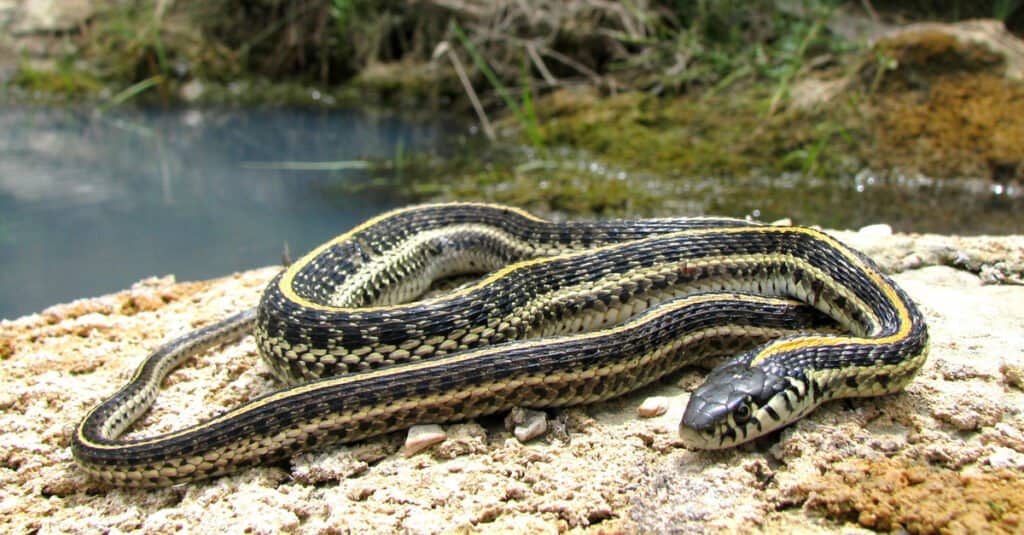
Plains Garter Snake (Thamnophis radix)
©Joe Farah/Shutterstock.com
The Plains Garter Snake is a common species of garter snake found in North Dakota. It is a non-venomous snake, known for its distinctive yellow stripes running down its brown or greenish-gray body. During the winter months, Plains Garter Snakes hibernate in dens or other underground shelters. They emerge in the spring and engage in mating rituals that involve prolonged courtship and pheromone signaling. Females give birth to live young in late summer or early fall.
Plains Garter Snakes can be found in a variety of habitats, including grasslands, prairies, wetlands, and agricultural fields. They are primarily active during the day and are known for their fast-moving and agile nature. Plains Garter Snakes are proficient swimmers and are considered semi-aquatic. They spend a significant portion of their lives in or near water. Plains Garter Snakes feed primarily on small fish, amphibians, and invertebrates. They are also known to consume rodents, other small mammals, and bird eggs.
Despite their harmless nature, Plains Garter Snakes are often killed out of fear or mistaken identity with venomous species. As such, it is important to exercise caution and respect when encountering these animals in their natural habitat. While the Plains Garter Snake is not listed as an endangered species, it is vulnerable to habitat loss and fragmentation due to agricultural development and urbanization. Conservation efforts in North Dakota focus on preserving and restoring native grasslands and wetlands, which provide important habitats for this and other wildlife species.
2. Western Ribbon Snake (Thamnophis proximus)
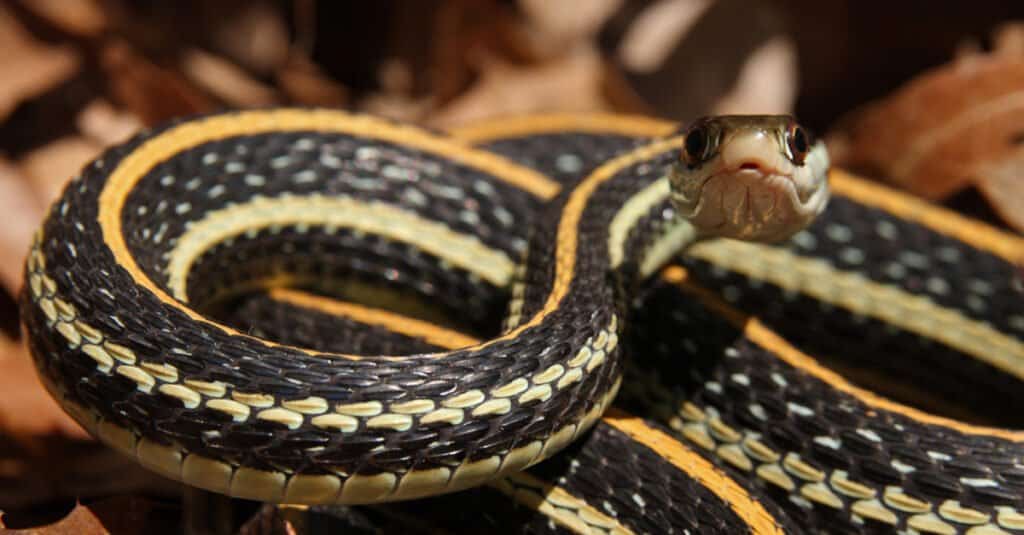
Western Ribbon Snake (Thamnophis proximus)
©Ryan M. Bolton/Shutterstock.com
The Western Ribbon Snake (Thamnophis proximus) is a semi-aquatic species of snake that is found in North Dakota. This snake is one of the largest of the ribbon snakes, growing up to three feet in length. Its body is grey-brown with three long stripes that run from the head to the tail, giving it a ribbon-like appearance.
The Western Ribbon Snake is usually found in lowland areas near water, such as swamps, streams, and rivers. It feeds on small fish, frogs, and aquatic invertebrates. This snake is active during the day and is often seen basking in the sun or swimming in the water.
The Western Ribbon Snake is a non-venomous species and is not considered dangerous to humans. However, like all wild animals, it should be treated with respect and left alone in its natural habitat.
The Western Ribbon Snake is considered a species of concern in North Dakota due to the loss of habitat and fragmentation of its range. Conservation efforts are underway to protect and restore the habitats where this snake is found.
3. Racers (Coluber constrictor)
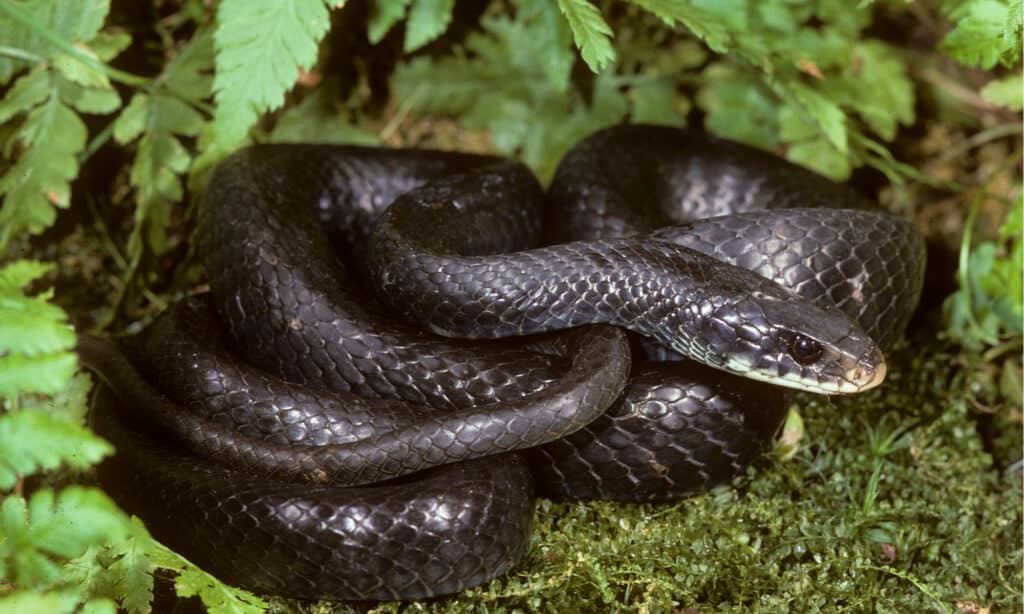
Racers (Coluber constrictor)
©Breck P. Kent/Shutterstock.com
Racer snakes are a species of nonvenomous snake that can be found in North Dakota, as well as other parts of the United States. They are known for their slender shape, fast movement, and non-aggressive nature. Racer snakes are typically green or brown in color with a lighter underbelly, but variations in color can occur depending on the region they are found in.
They are primarily active during the day and can often be seen basking in the sun on rocks or other exposed surfaces. Although not considered a true water snake or semi-aquatic, racer snakes are known to be good swimmers and can often be found in or near water sources such as ponds, streams, and rivers. They are able to swim using an undulating motion that is similar to the way they move on land. While they are primarily terrestrial and tend to avoid water when possible, they are not afraid to enter the water as needed.
4. Western Terrestrial Garter Snake (Thamnophis elegans)
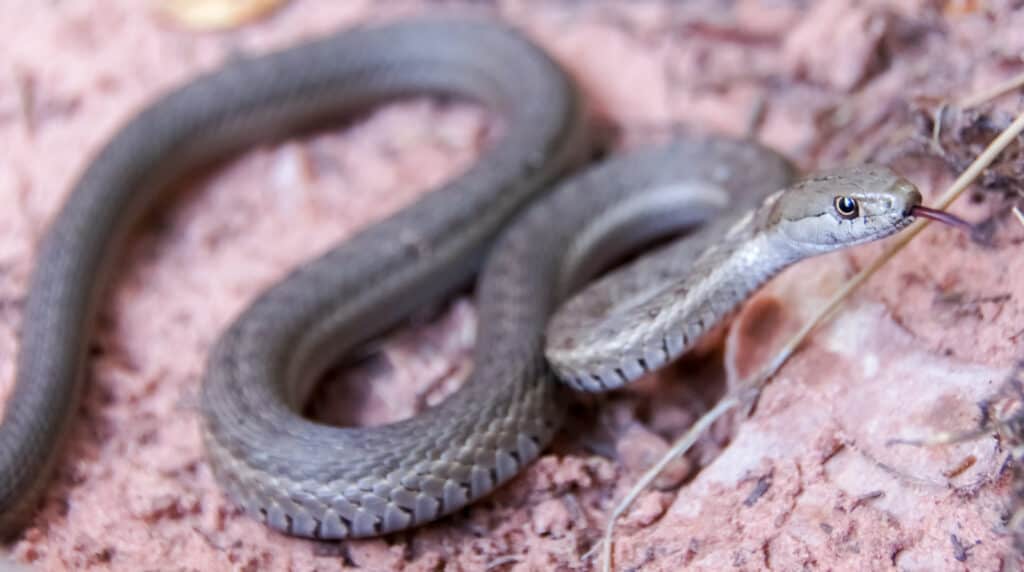
Western Terrestrial Garter Snake (Thamnophis elegans)
©iStock.com/yhelfman
The Western Terrestrial Garter Snake (Thamnophis elegans) is a snake found in western North America, including parts of Canada, the United States, and Mexico. It is found in North Dakota, primarily in the western part of the state. Although populations in the Rocky Mountains and great basins are semi-aquatic, it is mostly terrestrial.
While they spend most of their time on land, they are known to be excellent swimmers and can often be found near water sources such as rivers, streams, ponds, and lakes. These snakes have a distinctive appearance, with a long and slender body, and a pattern of yellow, orange, and black stripes. It is a medium-sized snake, typically growing up to around 2-3 feet long.
They are non-venomous and typically feed on a varied diet of insects, amphibians, fish, and small mammals. During the warmer months, Western Terrestrial Garter Snakes are active during the day, basking in the sun to regulate their body temperature. In cooler weather, they may become less active and spend more time in their dens.
While the Western Terrestrial Garter Snake is not considered a threatened species in North Dakota or nationally, its habitat is threatened by human development and habitat fragmentation. Conservation efforts are underway to protect and maintain the snake’s natural habitat.
Overall, the Western Terrestrial Garter Snake is an adaptable and fascinating species that plays an important role in their local ecosystems.
5. Prairie Rattlesnake (Crotalus viridis)
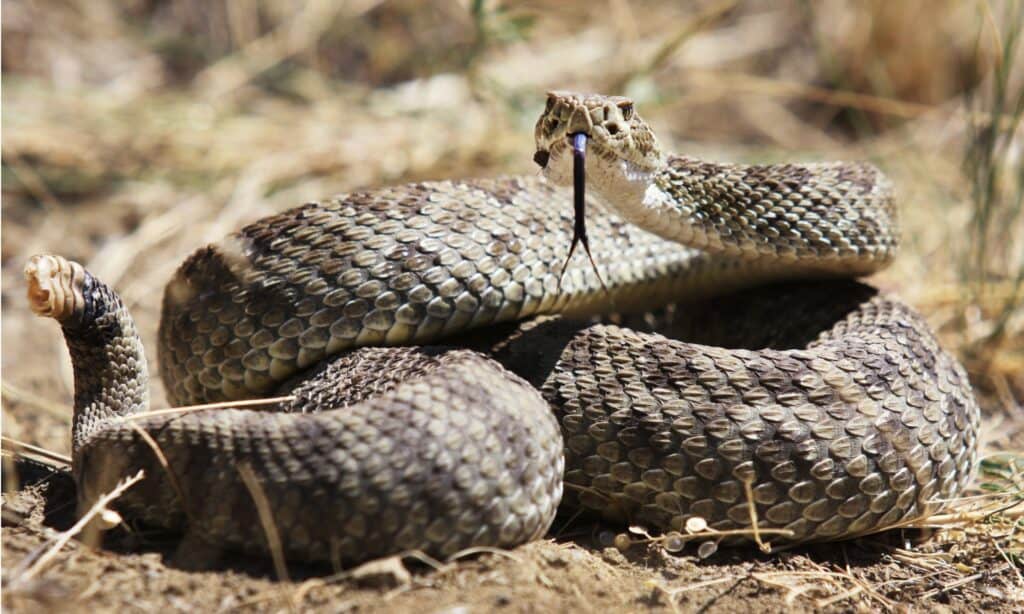
Prairie
rattlesnakes
(Crotalus viridis) are also called western rattlesnakes.
©iStock.com/HRossD
The Prairie Rattlesnake (Crotalus viridis), also known as the Western Rattlesnake, is North Dakota’s only venomous snake, and it is mainly found south and west of the Missouri River, inhabiting grassy areas, sagebrush, and woody areas. Prairie Rattlesnakes are not typically considered semi-aquatic, though they may sometimes be found near water sources such as streams or ponds. They are primarily terrestrial species that are found in rocky outcrops, open grasslands, and other dry habitats. However, some sources do describe them as occasionally entering the water to cool off during hot weather.
They are known for their distinctive rattle, which they use as a warning signal to deter potential predators. Prairie rattlesnakes are a relatively large snake species, ranging from 3-4 feet in length on average. They are active from April to October, and during the winter months, they hibernate in dens, usually located in rocky outcrops or underground. Prairie rattlesnake bites are rare but can be life-threatening if left untreated, and it is essential to seek medical attention immediately if you are bitten.
6. Bull Snake (Pituophis catenifer sayi)
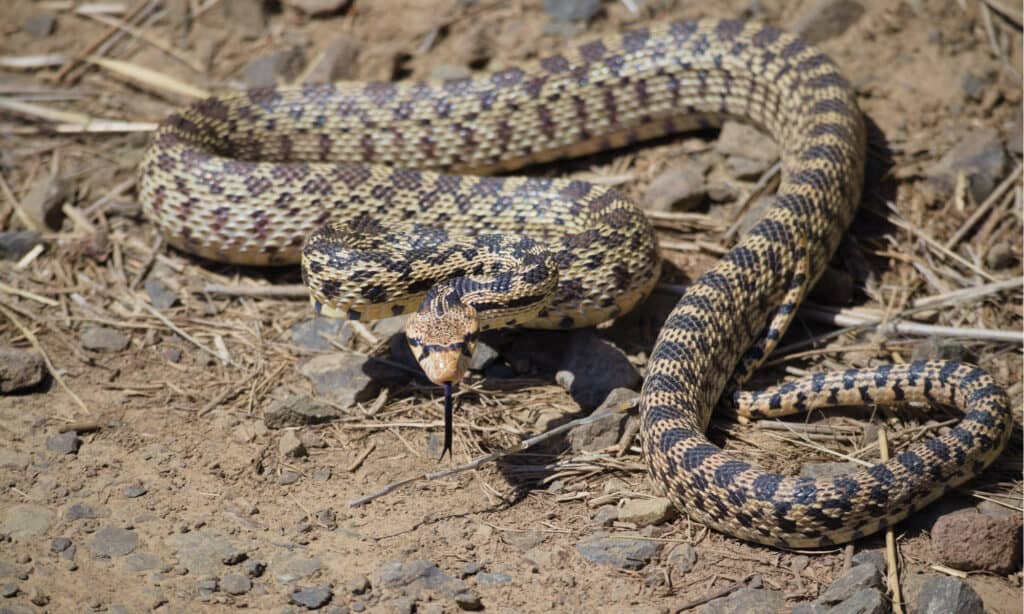
Bull Snake (Pituophis catenifer sayi)
©Christopher Joe Brown/Shutterstock.com
Bullsnakes (Pituophis catenifer sayi) are a non-venomous snake species that is found throughout North Dakota. They are commonly mistaken for Prairie Rattlesnakes due to their similar appearance, but they lack the rattle on their tail. Bull Snakes are not typically considered a semi-aquatic species. They are mainly terrestrial and can be found in grassy areas, rocky ground, and other dry habitats. However, some sources do suggest that they may sometimes inhabit areas near water sources, such as streams or rivers which makes them worth noting here.
Bullsnakes are large and can grow up to 6 feet in length. They are usually yellowish or light brown in color with a row of darker blotches running down their back. Bullsnakes are beneficial to the ecosystem as they help control rodent populations. Bullsnakes are not typically aggressive and will try to avoid confrontation with humans. However, they may hiss and rattle their tails as a defensive behavior if they feel threatened.
In Conclusion
All of these snakes are typically harmless unless provoked or threatened, even the Prairie Rattlesnake. However, a bite from the Prairie Rattlesnake can quickly become life-threatening. So, if you ever find yourself out exploring near any bodies of water in North Dakota keep an eye out for these amazing creatures but be sure to keep a safe distance!
Summary of 6 Water Snakes Found in North Dakota Waters
| # | Water Snake | Fun Fact |
|---|---|---|
| 1 | Plains Garter Snake | Are often mistaken for venomous snakes |
| 2 | Western Ribbon Snake | One of the largest ribbon snakes |
| 3 | Racers | Non-aquatic but a good swimmer |
| 4 | Western Terrestrial Garter Snake | Very adaptable and plays an important role in the ecosystem |
| 5 | Prairie Rattlesnake | Bites are rare but life-threatening |
| 6 | Bull Snake | Often mistaken for the prairie rattlesnake |
The photo featured at the top of this post is © Kit Leong/Shutterstock.com
Discover the "Monster" Snake 5X Bigger than an Anaconda
Every day A-Z Animals sends out some of the most incredible facts in the world from our free newsletter. Want to discover the 10 most beautiful snakes in the world, a "snake island" where you're never more than 3 feet from danger, or a "monster" snake 5X larger than an anaconda? Then sign up right now and you'll start receiving our daily newsletter absolutely free.
Thank you for reading! Have some feedback for us? Contact the AZ Animals editorial team.






